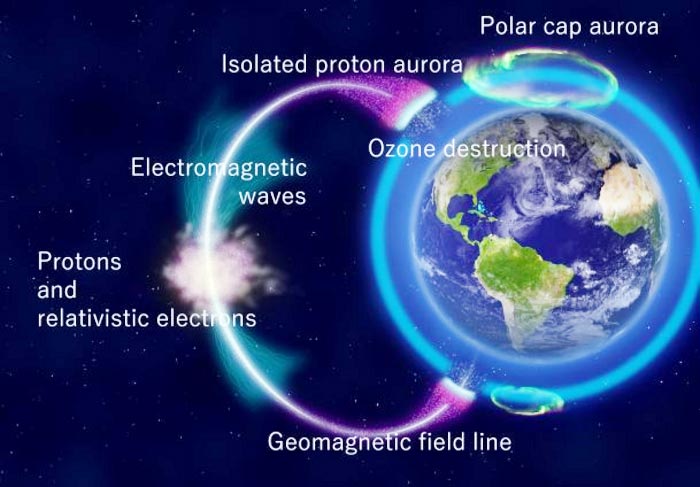Auroras to reveal a new factor that damages the ozone layer

For the first time, researchers reveal the formation of localized ozone depletion associated with the isolated proton aurora.
Credit: Kanazawa University
To assess damage caused to the ozone layer by charged particles in space that surround the Earth, an international team of researchers from Japan, the United States, and Canada studied a type of aurora called an “isolated proton aurora”. They found more damage than predicted by simulations, suggesting a new factor to consider when assessing damage to the ozone layer.
Along with solar radiation from the Sun, cosmic rays and high-energy plasma particles, such as ions and electrons, bombard the Earth’s atmosphere. Among these particles, electrons in the radiation belt, the layer that surrounds the Earth in space, may fall along magnetic field lines into the Earth’s atmosphere. When they fall, their charge ionizes the atmosphere and produces nitrogen oxides and hydrogen oxides. Both compounds contribute to ozone loss.
Although high-energy plasma particles damage the ozone layer, details of their impact are less well understood. This is because such particles are not visually observable, making it difficult to ascertain their location. However, when these charged particles interact with the upper atmosphere, they emit an isolated proton aurora that falls toward Earth. Normally, auroras appear as a belt around the north and south poles, however, these isolated proton auroras are visible as isolated spots or bands at lower latitudes.
Researchers from Nagoya University, Kanazawa University, and the National Institute of Polar Research in Japan; Johns Hopkins University in the USA; Athabasca University and the University of Alberta in Canada; NASA Langley Research Center; and the Japan Aerospace Exploration Agency (JAXA) investigated the ozone fluctuations below the isolated proton aurora to assess the impact of radiation-belt electrons. They reported their findings in Scientific Reports.
To detect electrons over the aurora, the team used a combination of satellite remote sensing, ground-based electromagnetic wave observations, and information from the International Space Station. For the first time, the data revealed the formation of a localized ozone hole in the middle atmosphere, about 400 km wide, which was associated with isolated proton auroras.
Comparing their results to simulations, the researchers found that the damage was much greater than predicted. Up to 10-60% of the ozone directly below the aurora was destroyed 90 minutes after it began. Since the localized damage was directly below the isolated proton aurora, the researchers compared it to a pinpoint hole in a shoji, the paper sliding doors found in traditional Japanese houses.
“Researchers from a wide range of research fields related to plasma physics, aurora science, trace atmospheric composition sensing, and electromagnetic wave engineering were brought together to achieve comprehensive observations through international cooperation,” explains team member Kazuo Shiokawa, a professor at the Institute for Space-Earth Environmental Research at Nagoya University. However, he points out that even those without sophisticated technology can see isolated proton auroras. “Isolated proton auroras can be observed by scientific all-sky cameras,” he said. “Although it is a rather weak aurora, it is also visible to a regular person.”
“This is the first observational study in the world to show that radiation belt electron fallout from space around the Earth has a direct, immediate, and localized effect on atmospheric changes in the mesosphere,” the researchers said. “This study revealed that radiation belt electrons falling into the atmosphere from space around the Earth have a rapid and localized effect on the composition of the microatmosphere, including ozone. This finding is expected to contribute to an improved prediction of changes in the Earth’s atmospheric environment by considering the effects of atmospheric ionization by high-energy plasma from space.”
“This result strongly suggests that the influence of radiation belt electrons cannot be ignored in predicting changes in the Earth’s atmospheric environment,” they concluded.
//Funding//
This work was supported by Grant-in-Aid for Scientific Research (JP16H06286, JP20H02162) from Japan Society for the Promotion of Science.
Journal: Scientific Reports
Article Title: Localized mesospheric ozone destruction corresponding to isolated proton aurora coming from Earth’s radiation belt.
Article Publication Date: 11-Oct-2022
Media Contact
Matthew Coslett
Nagoya University
kouho-en@adm.nagoya-u.ac.jp
Office: +81 (0)52-747-6862
@NagoyaUniv
All latest news from the category: Physics and Astronomy
This area deals with the fundamental laws and building blocks of nature and how they interact, the properties and the behavior of matter, and research into space and time and their structures.
innovations-report provides in-depth reports and articles on subjects such as astrophysics, laser technologies, nuclear, quantum, particle and solid-state physics, nanotechnologies, planetary research and findings (Mars, Venus) and developments related to the Hubble Telescope.
Newest articles

High-energy-density aqueous battery based on halogen multi-electron transfer
Traditional non-aqueous lithium-ion batteries have a high energy density, but their safety is compromised due to the flammable organic electrolytes they utilize. Aqueous batteries use water as the solvent for…

First-ever combined heart pump and pig kidney transplant
…gives new hope to patient with terminal illness. Surgeons at NYU Langone Health performed the first-ever combined mechanical heart pump and gene-edited pig kidney transplant surgery in a 54-year-old woman…

Biophysics: Testing how well biomarkers work
LMU researchers have developed a method to determine how reliably target proteins can be labeled using super-resolution fluorescence microscopy. Modern microscopy techniques make it possible to examine the inner workings…





















